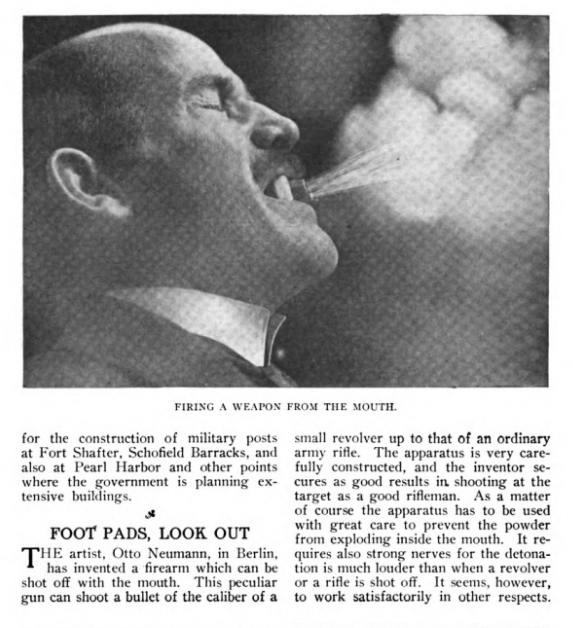Weapons
The Glmite Bomb
Before the atomic bomb, other "super bombs" were dreamed up and invented. One of the more notorious was Lester Barlow's Glmite Bomb. Barlow claimed it could kill everything within a 1000-yard radius, but when the U.S. military tested it in 1940, exploding it in a field surrounded by goats, it failed to kill, or even injure, a single goat.Glmite also has to be one of the worst names ever for an explosive. It was created by combining the words 'Glenn' and 'Dynamite'.
More details from The Ordnance Department: Procurement and Supply, by Harry Thomson and Lida Mayo —
Tests of the Barlow bomb took up a good deal of the time of Ordnance planners in April and May, extending down into the most anxious weeks in May. When the newspapers announced that goats would be tethered at varying distances from the bomb to determine its lethal effects, Congress and the War Department were deluged with letters of protest from humane societies and private citizens. All the concern turned out to be wasted. At the first test, the bomb leaked and did not go off; at the second, held at Aberdeen Proving Ground in late May, the explosion occurred, but the goats, unharmed, continued to nibble the Maryland grass.

Barlow supervising the set up of the Glmite Bomb.

The Algone Upper Des Moines - June 18, 1940

Explosion of the Glmite Bomb at Aberdeen Proving Ground
Note the goats in the right foreground, unharmed
Posted By: Alex - Tue Jun 09, 2020 -
Comments (2)
Category: 1940s, Weapons
Pigeon-Killing Death Ray
Dr. Antonio Longoria claimed that he had invented a death-ray. In tests it demonstrated the ability to kill pigeons at a distance of four miles. However, he destroyed his machine and vowed never to build another, insisting that he was “interested now only in doing something to help civilization.”
Spokane Chronicle - Oct 11, 1939

Tampa Tribune - Oct 13, 1939

Posted By: Alex - Fri Mar 06, 2020 -
Comments (0)
Category: 1920s, 1930s, Weapons
Pattern for Survival
Posted By: Paul - Sat Jan 11, 2020 -
Comments (2)
Category: Death, Dreams and Nightmares, PSA’s, War, Weapons, Atomic Power and Other Nuclear Matters, 1950s
The Ring Gun
Great article here.
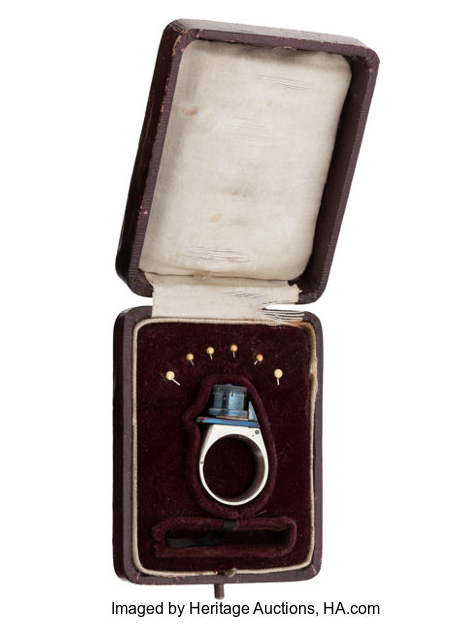
Posted By: Paul - Sun Oct 06, 2019 -
Comments (0)
Category: Enlargements, Miniatures, and Other Matters of Scale, Weapons, Nineteenth Century, Twentieth Century
Bob Harter’s “The Atom”
Posted By: Paul - Tue Sep 17, 2019 -
Comments (2)
Category: Ineptness, Crudity, Talentlessness, Kitsch, and Bad Art, Music, Politics, Propaganda, Thought Control and Brainwashing, PSA’s, War, Weapons, 1960s
Remco Monkey Gun
Nerf missiles? For wimps!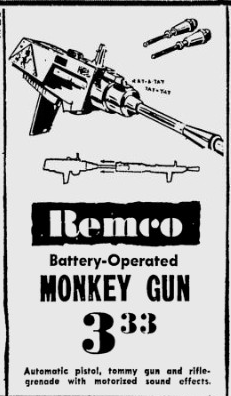
Posted By: Paul - Sun Sep 15, 2019 -
Comments (2)
Category: Destruction, Toys, 1960s, Weapons
Project Capricious
During World War II, the OSS (precursor to the CIA) hatched a plan to defeat General Rommel's Afrika Korps by using synthetic goat poop. The idea was to drop huge amounts of pathogen-laced pseudo-poop over African towns. Local insects would be attracted to the stuff and would then carry the pathogens to Rommel's troops. However, before the plan could be carried out, Rommel's troops were withdrawn from the area and sent to Russia.Jeffrey Lockwood tells the story in more detail in his book Six-Legged Soldiers: Using Insects as Weapons of War.
The plan was to weaken the enemy forces by using flies to spread a witch's brew of pathogens. Given the agency's inability to rear an army of flies, [OSS Research Director] Lovell decided to conscript the local vectors...
Lovell was a chemist, but he'd been out of the laboratory often enough to know that flies love dung. And with a bit of research, he discovered a key demographic fact: There were more goats than people in Morocco — and goat are prolific producers of poop. Lovell now had the secret formula: microbes + feces + flies = sick Germans. Now all he needed was a few tons of goat droppings as a carrier for laboratory-cultured pathogens.
The OSS collaborated closely with the Canadian entomological warfare experts to launch one of the more preposterous innovations in the history of clandestine weaponry: synthetic goat dung. Of course flies are no fools; they won't be taken in by any old brown lump. So the OSS team added a chemical attractant. The nature of this lure is not clear, but a bit of sleuthing provides some clues.
Allied scientists might have crafted a chemical dinner bell by collecting and concentrating the stinky chemicals that we associate with human feces (indole and the appropriately named skatole). While these extracts would have worked, the more likely attractant was a blend of organic acids, some of which had been known for 150 years. Two of the smelliest of these are caproic and caprylic acids, which, by no coincidence, derive their names from caprinus, meaning "goat." Etymologically as well as entomologically astute, Lovell named the operation Project Capricious. So with a scent to entice the flies, Lovell's team then coated the rubbery pellets in bacteria to complete the lures.
All the Americans had to do was drop loads of pathogenic pseudo-poop over towns and villages where the Germans were garrisoned, and millions of local flies would be drawn to the bait, pick up a dose of microbes, and then dutifully deliver the bacteria to the enemy. Lovell worried about keeping the operation clandestine. The Moroccans had to be persuaded that finding goat droppings on their roofs the morning after Allied aircraft flew over was a sheer coincidence. Presumably a good disinformation campaign can dispel almost any suspicion, or, as Lovell intimated, if the plan succeeded there would be very few people in any condition to raise annoying questions about fecal pellets on rooftops...
In the end, however, Lovell didn't have to worry about getting caught by either friends or foes, as the secret weapon was never deployed. Just as the OSS was gearing up to launch the sneak attack, the German troops were withdrawn from Spanish Morocco. They might well have preferred to take their chances with pathogen-laden flies, given that Hitler was sending them to the bloody siege of Stalingrad.
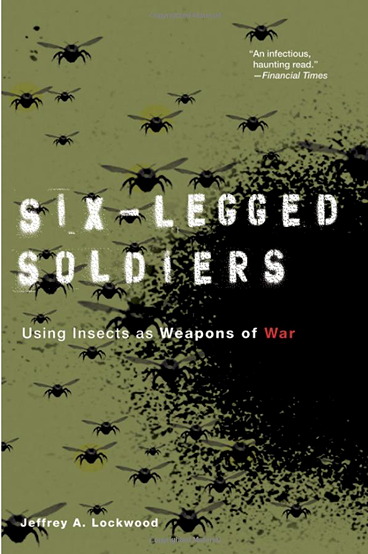
Posted By: Alex - Sat Jul 20, 2019 -
Comments (5)
Category: Insects and Spiders, Military, War, Weapons, Excrement, 1940s
Killer Rat
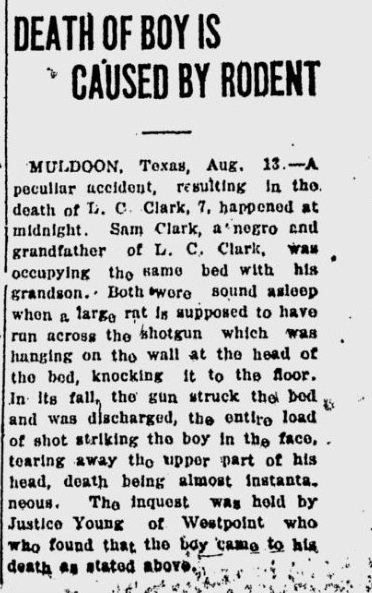
Our beloved Chuck Shepherd had a category in NOTW that might even have been finally considered "no longer weird." DOG SHOOTS OWNER.
But so far as I know, he never had a rat pulling the trigger.
Original article here.
Posted By: Paul - Tue Feb 19, 2019 -
Comments (0)
Category: Animals, Death, Children, 1920s, Weapons
Follies of the Madmen #400
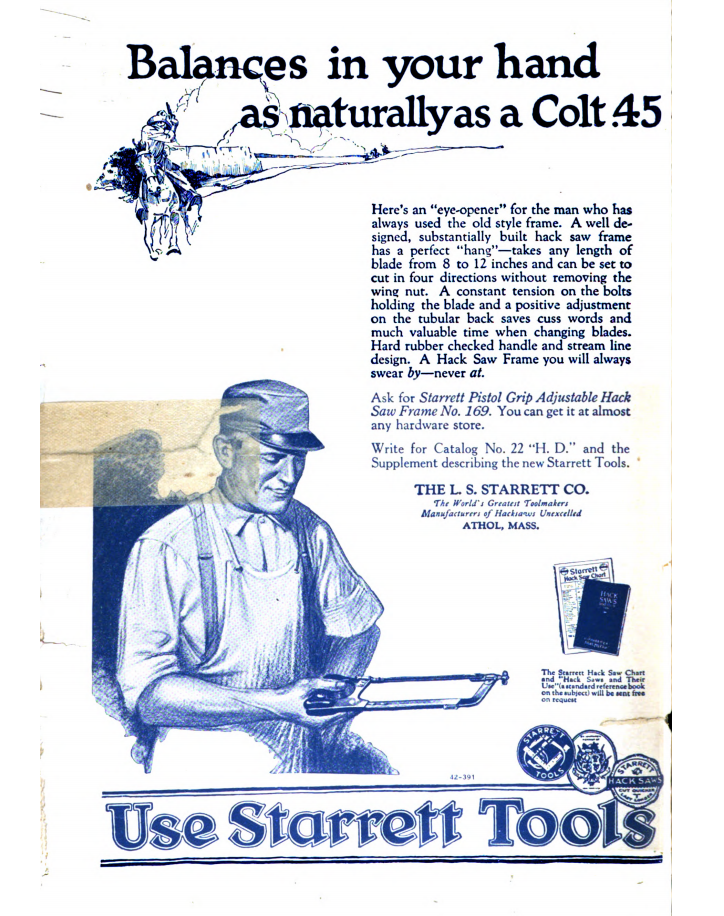
And just as lethal!
Original ad here.
Posted By: Paul - Mon Dec 10, 2018 -
Comments (6)
Category: Business, Advertising, Death, Tools, 1920s, Weapons

| Who We Are |
|---|
| Alex Boese Alex is the creator and curator of the Museum of Hoaxes. He's also the author of various weird, non-fiction, science-themed books such as Elephants on Acid and Psychedelic Apes. Paul Di Filippo Paul has been paid to put weird ideas into fictional form for over thirty years, in his career as a noted science fiction writer. He has recently begun blogging on many curious topics with three fellow writers at The Inferior 4+1. Contact Us |

